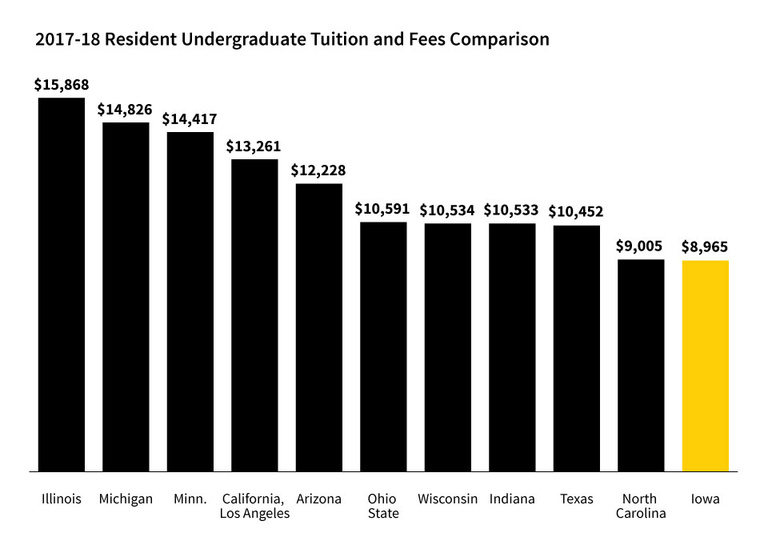At its June 5–7 meeting, the Board of Regents, State of Iowa, approved a 3.8 percent increase for undergraduate resident tuition and a 2.1 percent increase for nonresident undergraduates at the University of Iowa for the 2018–19 academic year. Changes will take effect beginning with the 2018 fall session.
UI undergraduate resident tuition will increase by $284 from $7,486 to $7,770. Nonresident undergraduate tuition will increase by $606 from $29,130 to $29,736. Mandatory fees also will increase by 1.2 percent or $18, increasing total annual fees from $1,478.50 to $1,496.50.
Resident students in most graduate and professional programs also will see tuition increase by 3.8 percent while nonresidents will see a 2 percent increase. However, graduate degree programs whose tuition rate match the UI peer median will see only a 2 percent increase as part of an effort to lessen the gap between UI tuition and the median of our peer group.
This spring, the Iowa legislature cut UI funding by $5.49 million, giving the university only three months to balance the budget before the end of fiscal year 2018. This prompted the university to impose a moratorium on construction projects to save funds. The legislature then approved a $3.15 million increase in state appropriations to the UI for FY 2019, leaving the university a net loss of $2.34 million in state support over the two-year period.
“The outcomes of our students are absolutely dependent upon the faculty and staff we are able to attract and keep here,” says UI President J. Bruce Harreld, “and the support we receive from the state directly affects our ability to do that. We are now having to make tough choices.”
Over the last 20 years, the university has experienced a generational disinvestment in public higher education. Since 1998, state funding for the UI has decreased by more than $8 million while the state budget has grown by nearly $3 billion and UI enrollment has grown by more than 5,000.
“The university has done its part and kept costs down—adjusted for inflation, we spend roughly the same amount per student today as 20 years ago,” says Harreld. “But with the state committing less support, we have to raise tuition or provide a lower-quality education than Iowans received 20 years ago—and we believe Iowans deserve the best.”
Undergraduate resident tuition and fees at the UI will remain among the lowest in its peer group and about $3,000 a year less than the average for said group.

As shown in the figure above, the UI’s tuition and fees were among the lowest in its peer group in 2017–18. Graph courtesy of the Office of Strategic Communication.
In four of the last ten years, the state has cut the UI budget mid-year. Overall state support for the university has declined such that tuition dollars now account for two-thirds of the UI’s General Education Fund. Among numerous other effects, this has prompted the UI to delay any potential performance and cost-of-living salary increases until January 2019, when tuition revenue and state support can be more accurately estimated and accounted for in university budgeting.